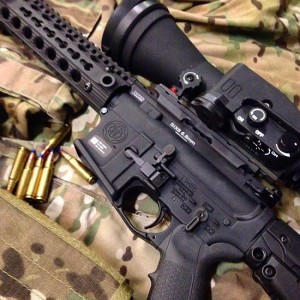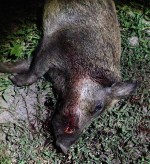From Failure to Success, The Fall of the 6.8 SPC and Rise of the 6.8 SPC II as a Hunting Round
How does a round designed to be a soldier’s answer to improving the 5.56 fail so miserably that it falls completely by the wayside eventually have the ability to succeed at being a well-rounded heavy hitting hunting round? It starts by having a company obsessed with getting the Remington 6.8 SPC in the military’s hands for testing. So bent on getting it out fast that they cut corners and produce poor untested, unfinished chamber designs. These corners were then followed by bad publicity due to its utter lack of performance. This should have spelled the end of the Remington 6.8 SPC that we now call our favorite AR15 hunting round. It took a handful of motivated individuals to see the rounds potential and then redesign the round from the ground up renaming it the 6.8 SPC II and making it what Remington should have done from the get go.
When I chose the 6.8 SPC II, I was looking for a new hunting round. My goal was a round for both deer and feral pig with an occasional coyote mixed in. I researched many different rounds and began narrowing them down by deciding what platform rifle I wanted to work with. I had decided on the AR15 instead of a bolt action because of the weight saving that can easily be had with an AR15. This narrowed my search down to a handful of rounds, the 243Winchester, 6.8 SPC II (or simply referred to as the 6.8) and the 6.5 Grendel. There were others but these seemed pretty popular at the time. My previous hunting rifle was chambered in 243Win and I wanted more punch so that ruled it out. That left two rounds, the 6.8 and the 6.5 Grendel. The 6.8 was an easy choice for me over the Grendel for 2 reasons, the Grendel performs much better in longer barrels while the 6.8 was designed to perform out of short barrels. The shorter barrel meant weight savings and ease of mobility. The other reason was that the 6.8 had a much larger selection of hunting bullets than the Grendel had to offer. At the time the 300 Black Out wasn’t on the market and even if it had been I wouldn’t have given it a second look, the round is underpowered for a true hunting application in my opinion.
Remington’s Strikes out with SPC
The short story of what went wrong with the Remington 6.8 SPC starts with Remington producing the round at the request of certain U.S. Special Operations troops who wanted a round with more knock down than the 5.56. In Remington’s rush to produce the round and subsequently design the chamber they took short cuts, plain and simple. The rifle was handed to the military for testing with a poor chamber design and the same rifling as its parent round the 270 Winchester. This combination created pressure spikes in the chamber forcing the ammunition to be loaded very anemic to meet the 55K PSI limitation of the AR15. This resulted in the US Military not adopting the round. Anemic rounds created poor ballistics on the factory ammo as well as not much better results from the reloading groups for the same reason. Remington all but abandoned the round and even to this day their 6.8 ammunition is the only ammunition loaded using old and poor design characteristics.
6.8 SPC II and its Rise to Hunting Infamy
The increased chamber pressure that plagued the first SPC chamber design are now gone, the proper twist rate has been worked out and these couple changes (plus a few more) gave birth to the SPC II. The SPC II is a huge leap forward from the original design. In fact there aren’t any manufacturers building anything using the old SPC designed chamber currently which minimizes past confusion. However because SPC II has still not properly been adopted by SAAMI, the load data in the reloading manuals is still on the light side. What most books called max loads is where we are starting our load testing when working up for our home brewed ammunition. This tends to still allow for the production of some misinformation out there regarding the potential of the round. There is a great source out there that any 6.8 owner should be utilizing and that is the 68forums.com. All the proper information regarding reloading data, proper rifle specs and other developments is readily available thanks to the folks over at the 68Forums.com.
The 68forums.com is dedicated to the 6.8 rifle and round and its development into what it is today. It’s unlike most other AR15 forums as it has always been more on the technical side of things, the industry partners involved are very proactive when it comes to continuously improving and promoting the round. In fact some key industry professionals that are currently on the 68forums started putting their heads together and really got the ball rolling with developing the round into a hunting round with real horsepower. They are the reason the round is what it is today with the new SPC II chamber and powerd. A round that could be used in shorter barrel rifles with devastating effect on game animals. Guys like Harrison Beene (AR15Performance.com), Art Kalwas(former owner of Silver State Armory) and Dr. Chris Lucci (Wild River Ranch, Texas) pushed the development of the new SPC II chamber, proper barrel twist rate and gas length, better loaded ammunition and the development of better hunting projectiles. I met Harrison and Dr. Lucci shortly after the introduction of the SPC II.
What’s important to note of the evolution is 3 things; the chamber, gas and twist were improved allowing a much hotter round without issues of overpressure (>55k PSI). This increased its velocity and range. Ammunition that matched the new chambers capabilities started being produced using .270 hunting projectiles that were already on the market (such as the Barnes 85gr TSX). These more powerful bullets could not be safely fired in the old Remington SPC chamber so this forced big rifle manufactures to improve their chambers to SPC II or be left behind, and lastly big bullet companies like Barnes Bullets and Hornady started producing a 6.8 specific hunting bullet with slower opening velocity speeds which extended the rounds effective hunting range, well past the mythical 300 yard wall.
There is one more thing regarding what I just discussed that is very noteworthy. There have been more than one large rifle manufacturer who got involved with the 6.8 SPC that came to the 68forums.com and directly asked for the assistance of the industry partners to help develop their rifle to what it should be instead of what it used to be. The industry partners immediately helped them even though they could be construed as competition. It was seen as more beneficial to help each other which would in turn help develop the round itself even further.
The Ammunition and Performance of the 6.8
I own two hunting rifles, my AR15 chambered in 6.8 SPC II and a Savage Bear Hunter chambered in 300WM. With both of these rounds I can safely and ethically hunt anything in North America. What I didn’t expect was the 6.8 to far surpass my hunting needs which ultimately limited my use of the 300WM to Elk season.
Barnes Bullets with the assistance of Chris Lucci of Wild River Ranch, Texas designed a new bullet in their TTSX line up specifically for the 6.8. It has a proper expansion threshold of 1600 feet per second (fps) and averages 2950 fps out of a 16” barrel. It is a fairly flat shooting round and is devastating to both Deer and Pigs. In my experience inside 250 yards the round will completely pass through either animal with ease dropping them in their tracks, it deforms nearly identical every time because of its copper monolithic design and it retains 95% of its weight. It punches a small 3⁄4” hole all the way through a perfect neck shot. On the surface the hole is less than impressive to look at until you look deeper and skin the animal. The area around the bullet path is large pie pan sized dark red blood shot area that shows the amount of energy the bullet carries with it.
Shortly after the Barnes TTSX bullet came out, Hornady brought their dedicated 6.8 round, the 120 SST to the table. While the 120 SST may be slower and have more of an arc to it (See previous article on 200 yard zero to get exact trajectory figures and how it affects the hunter) it has the highest ballistic coefficient of a hunting bullet used in this round. It also has the slower expansion velocity of 1600 fps. I have seen 3 different people shoot 2 different rifles using the Hornady 120 SST and all print 3 shot groups under 1/2” at 200 yards, that’s 1⁄4 MOA out of 2 similar AR15 hunting rifles using 3-9 power scopes. It is equally devastating to deer and pig with the typical wound pattern you’d expect from a jacketed lead core bullet. I know of several hunters who use the Nosler 110gr Accubond in 6.8 for Black Bear, I would not hesitate to use the Hornady 120gr SST for Black Bear either.
The above mentioned 2 bullets are milestones and game changers for the round but there are many more bullets and projectiles out there, such as 110gr Nosler Accubonds, Sierra Pro Hunters, various OTM ammo, and the list goes on (see picture 3). We are seeing more companies continuously coming into the fray, companies such as Federal and their introduction of their Fusion line of hunting ammo as well as their 90gr Gold Dot produced for a foreign military contract currently being fulfilled. The 6.8 SPC II is constantly growing and thriving in the hunting community. We are even seeing plinking ammo (S&B 110gr FMJ $13.50 a box of 20) and long range ammo (Berger 140gr VLD loaded through Silver State Ammunition, still supersonic at 1000 yards) hitting the shelves.
Future Endeavor’s for the 6.8 SPC II
Since the 6.8 SPC II has made a name for itself as one of the go to AR15 hunting rounds with its one shot DRT (dead right there) knock down power and the introduction of various hunting projectiles by some of the biggest names in hunting (Barnes, Berger, Nosler, Federal, Sierra, etc..) the only place I can see the round going from here is back to its roots as a combat round. Several overseas military contracts are currently being filled as of SHOT Show 2014, the DEA is currently using the 6.8 SPC II with the Hornady ammunition and various local law enforcement agencies are adopting it. What would kick it in the butt for the general population would be a more affordable plinking ammo. While the S&B at $13.50 a box is a huge improvement over years past it still has a ways to come down to be more price competitive for everyday use.
When customers discuss purchasing a 6.8 SPC II chambered upper or rifle from me I always ask them what they want to use it for. I always explain to them I think it’s a great self-defense round, it’s a phenomenal hunting round and its performance out of a short barrel is arguably second to none in the AR15 platform I do go on to explain that if you want it as a plinking rifle it will not fill that role well as the ammunition is still somewhat high when comparing it to the standard 5.56 plinking ammunition. However a complete 6.8 SPC II upper will just slap right on your normal 5.56 lower and you’re ready to rock, just have to add 6.8 specific magazines!
This round just continues to grow and impress me, what surprises me is that even with its huge success as a hunting round (light weight, soft recoiling, great out of a short barrel) many are still unaware of it and continue to try lesser performing rounds for hunting, rounds such as the 300BO.
A Word on the 300BO vs 6.8
This is not meant to start an argument over which round is better, its meant to discuss simply which role is best for which round. The 300BO is phenomenal for what it was designed for, an alternative military or LEO suppressed SBR CQC (Short Barreled Close Quarter Combat) rifle. It is impossible to take a smaller case (5.56 compared to 6.8), cut it down even smaller then pack a big .30 caliber bullet in the tiny case leaving very little room for powder and expect any kind of real velocity out of it. Slower velocity means heavier arc or lob. I have seen to many accounts of the 300BO being used for tough skinned animals such as pigs only to have the hunter state that it took multiple shots to down the pigs. I blame Remington for advertising the 300BO as a hunting round, which it is not. Now the alternative to that is the 6.8 for a CQC round, yes its great suppressed, yes its great out of short barrels but it’s extremely efficient and will have over-penetration issues in a CQC setting which makes the 300BO a superior choice for that role and the 6.8 a superior choice for hunting or even a stand off round.
Technical Mumbo Jumbo
You can stop right here and have a good understanding of the capability of the 6.8 or you can continue on and have a better understanding of the round, but I warn you this section isn’t designed to entertain as much as educate.
I personally have 3 different loads I use when running my 6.8 rifle, I will discuss my load make up for all three (no specific data to cover myself sorry), their ballistics, desired powders, primers, brass and alternative powders being used with great success. Any information not included here can be found on the 68forums.com. From here on out I will be calling the round simply 6.8 but it refers to the 6.8 SPC II only and should not be used in an older 6.8 SPC chamber.
First the Barnes 95TTSX load:
SSA Brass, AA2200 powder, CCI 41 primers, 2.295 COAL, no crimp. We use PRI 6.8 mags to achieve the longer COAL. We have found that the 6.8 benefits from the longer COAL.
This load produces 2950 fps out of a 16” ARP barreled IronworksTactical.com upper. The 95TTSX will effectively open fully on soft tissue all the way out to 438 yards, with 1702fps, 965 fpe (foot pounds energy). Considering most of us don’t shoot animals ethically past 300 to 350 yards that is very impressive.
Trajectory:
Yards inches Velocity/fpe
50 – 0.7 – 2786/2587
100 – 1.8 – 2629/2303
150 – 1.6 – 2478/2045
200 – 0.0 – 2331/1810
250 – 3.2 – 2189/1596
300 – 8.2 – 2052/1403 (or about 1mil hold)
350 – 15.3 – 1920/1228 (1 mil hold at ridge of animals back)
Second the Barnes 85 MPG load:
SSA Brass, Reloader 7, CCI 41 primers, 2.295 COAL
This load produces over 3000fps, it is a frangible round with a near identical trajectory as the 95TTSX load, it costs less than half the 95TTSX load in projectiles so I use it to shoot instead of the 95 for teaching, practicing etc.
Nearly identical trajectory as above
My alternate hunting round Hornady 120gr SST load:
SSA Brass, AA2200, CCI 41 primers, 2.295 COAL
This load produces 2450 fps out of a 16” ARP barreled IronworksTactical.com upper. The 120SST will effectively open fully on soft tissue all the way out to 430 yards, with 1615fps, 550fpe. The 550fpe is getting on the low side however the bullet is rated to have full expansion down to 1600fps. I have seen incredible accuracy with this projectile. You can expect identical performance out of Hornadys factory 120SST load.
Trajectory:
Yards inches Velocity/fpe
50 – 1.4 – 2342/1157
100 – 2.7 – 2237/1056
150 – 2.3 – 2134/961
200 – 0.0 – 2035/874
250 – 4.4 – 1938/792
300 – 11.1 – 1844/717 (or 1 mil hold exactly)
350 – 20.4 – 1753/648 (1 mil hold on ridge of animals back)
Alternative powders are Reloader 10x and 1200-R, primers are CCI 450 (back off the powder load first), Hornady brass is great brass and seems to be more consistent than the newer SSA brass but the wall density is different so you may need to tweak your powder charge.
- Night Vision Pig Hunting Training with Wild River Ranch and Ironworks Tactical - September 22, 2015
- The Fall of the 6.8 SPC and Rise of the 6.8 SPC II as a Hunting Round - August 30, 2014




